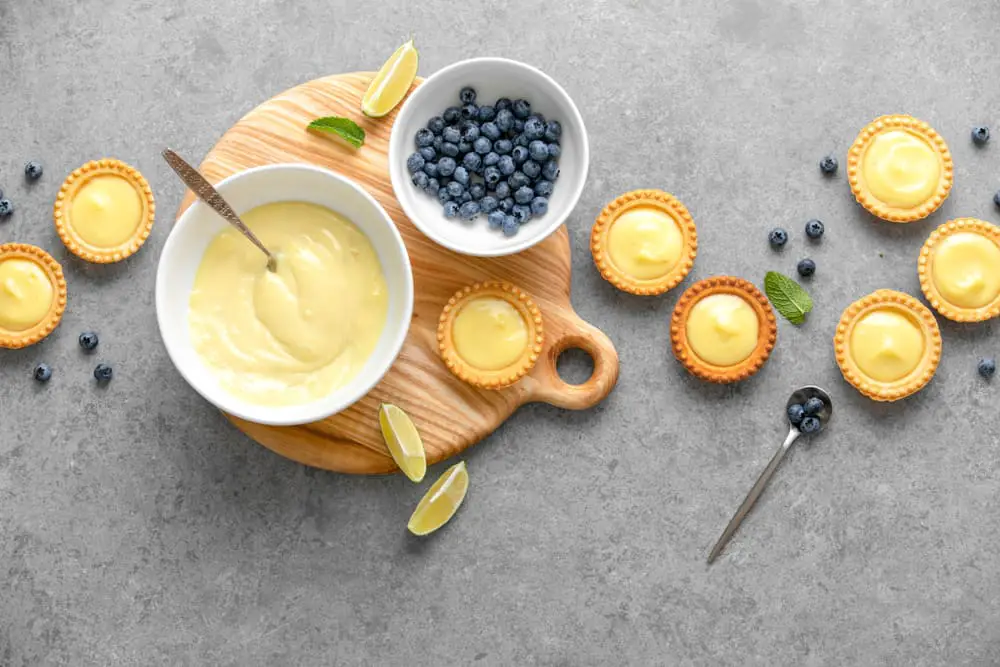Last Updated on 24th November 2021 by
Curd and custard taste great in different ways. Besides their heavenly tastes, they also might look alike and possess several similarities when it comes to ingredients, thickness, and creaminess.
However close these two look similar in one way or another, they have notable differences. Here is a guide of curd vs custard that you need to know.
What Is Curd?
Curd is a by-product of milk. You get it through coagulating milk by adding any acidic substances like vinegar or lemon juice. Rennet is also a good substance you can add.
Once you’ve added acid in fresh milk, the protein parts develop into solid masses, otherwise known as curds. Alternatively, you can leave the milk to sour on its own for some time and allow it to curd naturally.
Depending on what you use to make your curd, you’ll get one of the two types of curd; for lactose-intolerant persons also called Chhena in India and one that’s not for lactose intolerant individuals.
The first alternative uses acid that produces lactose into water. On the other hand, using rennet produces curd that attaches to lactose that is useful for products like cheese used for commercial purposes.
How Do You Make Lemon Curd at Home?
Making curd at home provides you with a product that contains your personal preferences when it comes to quality and flavours. The making process is very straightforward and easy to master. All you need is 2 cups of milk and lemon juice, rennet, or vinegar.
How to Make Lemon Curd at Home
Instructions
- To prepare the best curd, you need good quality milk as a start.
- Boil your milk to ensure it does not spoil as you ferment it using acid or rennet. Heat it at a temperature above 85 Degrees Celsius.
- Let the milk be warm when you dip your finger in. If too hot, it will coagulate, leaving curd that is too grainy that will deny you the thickness most people seek from their curd. Cold milk is also not good for making curd because it won’t gain the curd at all. The ideal temperature is between 39 to 44 Degrees Celsius.
- Then put lemon juice or rennet into your milk evenly as you stir or whisk.After you’ve created a thick curd using the milk, put it in a container that will retain its heat for a while or place it in a warm place like the kitchen for four to seven hours.
- You can flavour your curd as you wish – use sugar or any other sweetener you wish.
- After the curd is set and you are satisfied with the results, refrigerate it for eight to 12 hours.
What are the Benefits of Eating Curd
Curd can be taken on its own as well as alongside other foodstuffs. It is not only easy to make but contains a myriad of benefits for the body as well.
Owing to its moisturising effect, protein and nutrient contents, plus probiotic properties, you’ll enjoy a stronger immunity, nourished skin, good digestion, reduced high blood pressure, and stronger bones by taking curd daily. For women, it can help prevent vaginal infections.
What is Custard?
Custard contains milk, cream, pasteurised egg yolk, and sugar. It is the yolk content that makes it different from ice cream which acts as a thickener. Custard also contains about 20% of overrun (whipped air in the mixture). On some occasions, this product will contain flour, gelatine, or cornstarch.
Depending on the ingredients you use, the final product of custard will have different consistencies – from a thick liquid that you can poor, to a thick paste that you can scoop using a spoon.
When it comes to Curd Vs Custard, curd is easier to make compared to custard that entails a delicate balance of the elements.
How Do You Make Custard from Scratch?
When we compare curd vs custard preparation, making custard may seem a complicated process but it actually is simple than it sounds. You can prepare it at home for your family to enjoy.
What you need is two egg yolks, two teaspoons of cornflour, a cup of milk, a teaspoon of sugar, and a flavouring agent.
How to Make Custard at Home
Instructions
- Put the egg yolks, sugar, and cornflour in a jug and mix them using a whisk until they make a single combination.
- Then take your milk and your flavouring agent and warm them together on a pan. Don’t make them hot.
- Take your warm flavoured milk and mix it with egg product in the first step, and put them back in the pan. Boil the mixture as you whisk all through the heating process.
- After boiling, remove it on the heat source and continue with the whisking until you get a thick paste that sticks on the surface of your spoon. If it does not thicken, return it on heat and let it lose some of its water contents.
Notes
What are the Benefits of Eating Custard
Just like curd, you can take custard on its own or use it as a part of most of the desserts out there. The choice is yours. But regardless of how you prefer to take it, you’ll enjoy the benefits that come with its ingredients.
It is a great source of calcium and Vitamin B12.
But it also comes with its share of setbacks if you take it frequently. It can lead to weight gain, heart disease, diabetes, and cancer.
If you are allergic to milk or eggs, beware that its ingredients can affect you. Taking custard can also promote blood sugar spikes as a short term effect. Since you’ll be making it at home, it’s recommended that you make custard from as many natural ingredients as possible.
I'm Pauline, a mother of four grown children, my passion for cooking stemmed from the joy i get cooking for my family. I love to try new dishes, especially when dining out but creating and sharing my own recipes is my favourite thing to do!


